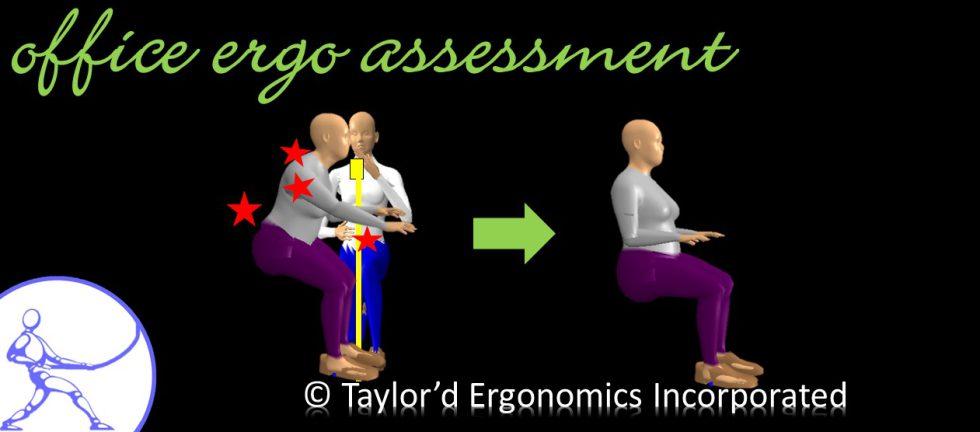In Canada, the CCCPE (www.cccpe.ca) governs certification for professional ergonomists , but the College does not publish “rules” for how an ergonomics assessment should be done. Locally, at Taylor’d Ergo, we have a very clearly documented process, which allows us to provide a consistent, thorough assessment. In our opinion, a full office ergonomics assessment should include:
- A survey and interview that allow the ergonomist to understand where, when, and how much discomfort you experience, how you spend your day (sitting, standing, what type of software, meetings, paper, portable devices), what type of vision correction you use, and what your main concerns are
- Measurements of how your furniture is currently set up, and of your key body dimensions (nothing too personal!)
- Observations and photos of you, taken while you work, so that YOU can see the postures that you work in
- Coaching to teach you how to adjust anything that can be adjusted, to make you more comfortable and productive
- Coaching to encourage you to use better work practices where possible
- Identification of outstanding issues, and development of recommendations for next steps
- Recommendations for your supervisor to make specific repairs and purchases
- A written report that summarizes all of the above
- Follow-up to ensure that you are more comfortable after the changes have been made, and to correct any outstanding issues.
The follow-up survey or interview is really a critical piece. If the process didn’t make you feel more comfortable, the ergonomist would continue to work with you to find a solution that works. Admittedly, not everyone remits the follow-up surveys, especially if their issues have disappeared. (We’re fairly confident that those with outstanding issues are letting us know.) Because the survey asks “how much” and “how often” people experience discomfort, we can do pre/post comparisons. A decade ago, we presented a paper at our annual ergo conference that reported on our success – 100% of those who sent back follow-up surveys reported improved comfort!
So….if you have discomfort after an office ergo assessment, was it done properly? Ergonomics means “fitting work to workers”, so, by definition, an ergonomics assessment should improve your comfort at work. Sometimes, recommendations involve two steps. For example, the ergonomist might ask you to try a different work practice, because it’s the best solution to the issue; if that doesn’t work for you, we’ll recommend an alternative recommendation during follow-up. If you’re still uncomfortable after all of the recommendations have been implemented and you’ve had time to adjust, contact the ergonomist and ask if there are alternatives that you could try.
We do need to acknowledge that not all discomfort stems from the workplace; if you spend 6 hours every evening thumbing your phone, adjusting your office keyboard height will only address half the problem. If you’re uncomfortable in an “ergonomic” workstation, ask yourself if what you’re doing at home might be contributing to your discomfort. Do you “work” ergonomically at home?
Sometimes damage from an injury or illness takes a long time to heal, and ergonomics is just one part of the solution. You might need more time. If work didn’t create your discomfort, then the best we might expect from an ergo intervention is that work should not aggravate your discomfort.
If you had an assessment that didn’t result in any improvement, you should be asking questions.
Can’t have an ergonomist in your workplace right now? We can also do remote office ergo assessments – these are usually more observation-based, if we can’t take measurements. Our “flat rate” assessments, available here, aim to optimize comfort using items that home-office workers typically have available in the house. We’ve had great success with guiding employees through the adjustment process via video chat! If you want the ergonomist to recommmend purchases for the home office, we coach the employee to measure key parameters during the assessment, and we use your preferred vendors to recommend appropriate items; contact info@taylordergo.com for a quote for this type of assessment.
We’re often asked to provide “mini” assessments – to visit employee workstations and help with adjustments. We do these, usually following a morning “face-2-face” workshop so everyone learns the basics at the same time. These “mini-assessments” are great proactive measures for employees who are curious and interested in prevention, and they work especially well in conjunction with an office move or furniture upgrade. However, if an employee is already experiencing significant discomfort, a full assessment is a more appropriate intervention.
Interested in scheduling a single office assessment? Please visit our store. If you’d like to offer assessments for more than one employee at your workplace, contact info@taylordergo.com for a quote based on our full day rates.


